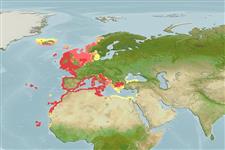Actinoptérygiens (poissons à nageoires rayonnées) >
Clupeiformes (Herrings) >
Clupeidae (Herrings, shads, sardines, menhadens) > Alosinae
Etymology: Sardina: Latin and Greek, sarda = sardine; name related to the island of Sardinia (Ref. 45335).
Environnement / Climat / Gamme
Écologie
; marin; eau douce; saumâtre; océanodrome (Ref. 51243); profondeur 10 - 100 m (Ref. 5286), usually 25 - 100 m (Ref. 54866). Subtropical, preferred 16°C (Ref. 107945); 68°N - 14°N, 32°W - 43°E (Ref. 54866)
Northeast Atlantic: Iceland (rare) and North Sea, southward to Bay de Gorée, Senegal. Mediterranean (common in the western part and in Adriatic Sea, rare in the eastern part), Sea of Marmara and Black Sea.
Length at first maturity / Taille / Poids / Âge
Maturity: Lm 14.8 range ? - ? cm
Max length : 27.5 cm SL mâle / non sexé; (Ref. 74552); common length : 20.0 cm SL mâle / non sexé; (Ref. 188); âge max. reporté: 15 années (Ref. 35388)
Épines dorsales (Total): 0; Rayons mous dorsaux (Total): 13-21; Épines anales 0; Rayons mous anaux: 12 - 23. Body sub-cylindrical, belly rather rounded (but more compressed in juveniles). Hind margin of gill opening smoothly rounded (without fleshy outgrowths) ; 3 to 5 distinct body striae radiating downward on lower part of operculum; lower gill rakers not becoming shorter at angle of first gill arch, the upper series not overlapping the lower. Last 2 anal fin rays enlarged.
Littoral species (Ref. 6808). Form schools, usually at depths of 25 to 55 or even 100 m by day, rising to 10 to 35 m at night. Feed mainly on planktonic crustaceans, also on larger organisms. Spawn in batches (Ref. 51846), in the open sea or near the coast, producing 50,000-60,000 eggs with a mean diameter of 1.5 mm (Ref. 35388). Marketed fresh, frozen or canned. Also utilized dried or salted and smoked; can be pan-fried, broiled and microwaved (Ref. 9988).
Breeds at 20 to 25 m, near the shore or as much as 100 km out to sea.
Whitehead, P.J.P., 1985. FAO Species Catalogue. Vol. 7. Clupeoid fishes of the world (suborder Clupeioidei). An annotated and illustrated catalogue of the herrings, sardines, pilchards, sprats, shads, anchovies and wolf-herrings. FAO Fish. Synop. 125(7/1):1-303. Rome: FAO. (Ref. 188)
Statut dans la liste rouge de l'IUCN (Ref. 115185)
CITES (Ref. 94142)
Not Evaluated
Menace pour l'homme
Harmless
Utilisations par l'homme
Pêcheries: hautement commercial
Outils
Can't connect to MySQL database fbquizv2. Errorcode: Too many connections
